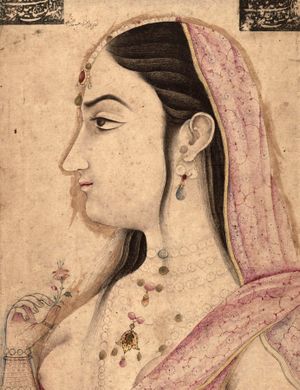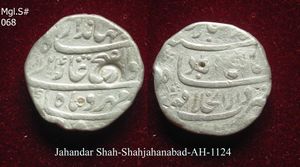جهاندار شاه
| جهاندار شاه Jahandar Shah | |||||
|---|---|---|---|---|---|
 | |||||
| العهد | 27 فبراير 1712 – 11 فبراير 1713 | ||||
| التتويج | 29 مارس 1712 في لاهور | ||||
| سبقه | بهادر شاه الأول | ||||
| تبعه | Farrukhsiyar | ||||
| وُلِد | 9 مايو 1661 الدكن، امبراطورية المغول | ||||
| توفي | 12 فبراير 1713 (aged 51) دلهي, امبراطورية المغول | ||||
| الدفن | |||||
| Spouse | Anup Bai Saidat-un-Nisa Begum Imtiaz Mahal Begum Lal Kunwar Jina Begum | ||||
| الأنجال | Muhammad Azhar-ud-Din Bahadur A'az-ud-Din Wali Ahd Bahadur Muhammad Aziz-ud-Din Bahadur Alamgir II Izz-ud-Din Bahadur Said-un-Nisa Begum Iffat Ara Begum Rabi Begum | ||||
| |||||
| البيت | التيموري | ||||
| الأسرة | التيمورية | ||||
| الأب | بهادر شاه الأول | ||||
| الأم | Nizam Bai | ||||
| الديانة | الإسلام | ||||
| أباطرة المغل | ||||||||||||||||||||||||||||||||||||||||||||||
|---|---|---|---|---|---|---|---|---|---|---|---|---|---|---|---|---|---|---|---|---|---|---|---|---|---|---|---|---|---|---|---|---|---|---|---|---|---|---|---|---|---|---|---|---|---|---|
|
||||||||||||||||||||||||||||||||||||||||||||||
مرزا معز الدين بيگ محمد خان (فارسية: میرزا معزالدین بیگ محمد خان ، جهاندار شاه Jahandar Shah، (و. 10 مايو 1661- ت. 11 فبراير 1713)،[1][2] وكان يشتهر بإسم جهاندار شاه (فارسية: جهاندار شاه, lit. ' The owner of the World' Persian pronunciation: [d͡ʒa'hɑːndɑːr ʃɑːh])، كان تاسع امبراطور للمغل الذي حكم الهند في الفترة الوجيزة من (1712-1713). وكان لقبه شاهنشاه غازي أبو الفتح معز الدين محمد جهاندار شاه صاحب القرآن پادشاه جهان (خلد أرمگاه). He was the son of Bahadur Shah (Shah Alam), and the grandson of Alamgir (Aurangzeb). Jahandar Shah was the first puppet ruler of the Mughal dynasty, having been placed on the throne by powerful noble Zulfiqar Khan. His reign was short and turbulent, lasting less than a year. He was deposed and succeeded by his nephew Farrukhsiyar with the backing of the Sayyid brothers in 1713.
حياته المبكرة
Prince Mu'izz-ud-din was born on 10 May 1661 in Deccan Subah to Prince Muazzam, later Emperor Bahadur Shah I. His mother was Nizam Bai, the daughter of Fatehyawar Jang, a noble from Hyderabad.[3] He was Muazzam's eldest son,[4] and eldest grandson of reigning emperor Aurangzeb. Following Mughal tradition, his birth was grandly celebrated by the Mughal court.[5] During Aurangzeb's reign, he participated in military campaigning in the Deccan for three years, after which he was permanently shifted to northern India.[6]
After Aurangzeb's death, prince Muazzam won the ensuing succession struggle and in June 1707, ascended the throne as Bahadur Shah.[7] Upon his father's accession, Mu'izz-ud-din was awarded the title Jahandar Shah, and made governor of Thatta and Multan.[8] Through the course of Bahadur Shah's reign, Jahandar Shah would stay at the imperial court, like the other sons of Bahadur Shah. This was because Bahadur Shah had ascended the throne at an old age, and the princes wanted to be within close reach of the throne in case of his demise.[9]
حرب الخلافة
A war of succession began as Bahadur Shah lay on his deathbed in 1712. The most powerful prince at the time of his death was his second son Azim-us-Shan, who had amassed significant resources as governor of the wealthy Bengal province. On the other hand, Jahandar Shah was the weakest, with little-to-no military power or funds. Unlike previous Mughal wars of succession, the outcome of this war was engineered by a noble, Zulfiqar Khan, the mir bakhshi and one of the most powerful figures in the Mughal empire. He built an alliance between Jahandar Shah, and his younger brothers Rafi-us-Shan and Jahan Shah, proposing to them that they could divide the empire between them upon victory (with Zulfiqar Khan serving as their common mir bakhshi). Azim-us-Shan was defeated and killed, following which Jahandar Shah broke the alliance and turned on his brothers, defeating them and killing them with the help of Zulfiqar Khan, emerging as the victor of the succession struggle.[10][11]
عهده
Jahandar Shah was crowned on 29 March, 1712.[12] His accession was not well-supported in the empire, and he was viewed as an illegitimate ruler. Hence, upon his coronation, Jahandar Shah moved to consolidate his authority by rewarding and promoting his supporters. However, he departed from previous Mughal succession practices. While his predecessors followed the custom of pardoning adversaries and reintegrating them into the imperial fold, Jahandar Shah more severely punished noblemen that had supported his brothers in the succession struggle, with several of them being executed. He also let the bodies of the defeated princes rot in the open for several days before their entombment, unlike previous emperors who had insisted on a proper burial.[13]
With Jahandar Shah's accession, Zulfiqar Khan assumed the post of wazir. Due to Jahandar Shah's full dependence on him, and the circumstances of his accession to the throne, effective power was wielded not by the emperor but by Zulfiqar Khan himself. This was the first occurrence in Mughal history that absolute power over the empire was wielded by an outsider to the dynasty. As the effective ruler during Jahandar Shah's reign, Zulfiqar Khan sought to establish amicable relationships with the Rajputs, Sikhs, and Marathas, and bring back peace in the empire. However, the empire's finances were deteriorating, continuing a trend that had begun with Jahandar Shah's predecessors, which decreased the empire's military effectiveness. The excessive power enjoyed by Zulfiqar Khan caused Jahandar Shah to conspire against him, creating political chaos.[11]
During his reign, Jahandar Shah married courtesan Lal Kunwar, who was considered to be of lowly origins; she became his favoured wife, and subsequently her family gained unprecedent power and status. Jahandar Shah also indulged in feasts and entertainments. Contemporary chroniclers and later historians have pointed out such aspects of the emperor's personal life, and the cruelty meted to his opponents, as reasons behind the turbulence of his reign. However, recent scholars highlight other factors; Munis Faruqui emphasizes his political weakness as a prince, which set him up for failure as a ruler. Abhishek Kaicker notes that nobles had themselves became more self-interested around the time of Jahandar Shah's accession, and that the "cruelty" of his reign was their biased defense for siding with Farrukhsiyar, who deposed Jahandar Shah.[11][14][15]
Deposition
Jahandar Shah's accession invited the challenge of claimant Farrukhsiyar, son of Jahandar Shah's deceased brother Azim-us-Shan, who was based in Bengal. With little independent resources, he unsuccessfully attempted to find backing for his bid. He eventually found powerful support in the Sayyid brothers, Husain Ali Khan and Abdullah Khan, administrators of Azim-us-Shan who had been removed from their postings by Jahandar Shah.[16][11] With their resources and political connections, Farrukhsiyar assembled a rebel army and advanced on the throne. The underpaid imperial army was defeated in battle near Agra in early 1713.[17]
وفاته
Upon defeat, Jahandar Shah fled to Delhi and sought refuge at the house of Zulfiqar Khan and his father Asad Khan. However, the two imprisoned him and turned him over to Farrukhsiyar, in hopes of securing his favour. Farrukhsiyar had both Jahandar Shah and Zulfiqar Khan executed, with Jahandar Shah being beaten to death and then beheaded on 11 February, 1713.[18] Jahandar Shah's body was paraded around Delhi in parts, hanging upside down from two elephants.[19] He was buried in Humayun's tomb.[18]
Marriages
Jahandar Shah's first wife was the daughter of Mirza Mukarram Khan Safavi. The marriage took place on 13 October 1676.[20] After her death he married her niece, Sayyid-un-Nisa Begum, the daughter of Rustam Mirza. The marriage took place on 30 August 1684.[21] Qazi Abu Sa'id united them in the presence of Emperor Aurangzeb, and Prince Muazzam (future Bahadur Shah I).[22] The marriage was consummated on 18 September. Sayyid-un-Nisa Begum was presented with jewels worth 67,000 rupees. The celebrations were supervised by Princess Zinat-un-nissa Begum.[23]
His third wife was a Rajput Princess, Anup Bai.[24] She was the mother of Prince Muhammad Aziz-ud-din Mirza, born on 6 June 1699. She died at Delhi on 17 April 1735,[21] nineteen years before her son's accession to the throne as Emperor Alamgir II. His fourth wife was Lal Kunwar, the daughter of Khasusiyat Khan.[25] Jahandar Shah was very fond of her, and after his accession to the throne, he gave her the title Imtiyaz Mahal.[21]
Full Title
His full title was Shahanshah-i-Ghazi Abu'l Fath Mu'izz-ud-Din Muhammad Jahandar Shah Sahib-i-Qiran Padshah-i-Jahan (Khuld Aramgah).
Coins
Jahandar Shah reintroduced couplets and issued coins in gold, silver, and copper. Two couplets i.e. Abu al-Fateh and Sahab Qiran were used. Copper coins were issued in both weight standard i.e. 20 grams and 14 grams.[بحاجة لمصدر]
ملاحظات
- ^ Nigam, S. B. P. (1983). The Jahandarnamah of Nur- ud-rin. Journal of Indian History. Vol. 61. Department of Modern Indian History. p. 95.
- ^ Montgomery-Massingberd, Hugh (1977), Burke's Royal Families of the World, II, Burke's Peerage, p. 139, ISBN 978-0-85011-029-6, https://books.google.com/books?id=bnsUAQAAIAAJ
- ^ Muni Lal, Mini Mughals (1989) p. 28
- ^ Faruqui 2012, p. 287.
- ^ Faruqui 2012, p. 70.
- ^ Faruqui 2012, p. 299.
- ^ Faruqui 2012, p. 311.
- ^ Irvine, William (1971). Later Mughals. Atlantic Publishers & Distributors. p. 36.
- ^ Faruqui 2012, p. 312.
- ^ Faruqui 2012, p. 310 & 315-317.
- ^ أ ب ت ث A history of modern India, 1480-1950. Claude Markovits, Nisha George, Maggy Hendry. London: Anthem Press. 2002. pp. 174–175. ISBN 1-84331-004-X. OCLC 50175836.
{{cite book}}: CS1 maint: others (link) - ^ Chandra, Satish (2002). Parties and politics at the Mughal Court, 1707-1740 (4th ed.). New Delhi: Oxford University Press. p. 107. ISBN 0-19-565444-7. OCLC 50004530.
- ^ Faruqui 2012, p. 318.
- ^ Faruqui 2012, p. 317.
- ^ Kaicker, Abhishek (2020). The king and the people : sovereignty and popular politics in Mughal Delhi. New York, NY. pp. 187–189. ISBN 978-0-19-007070-0. OCLC 1114271590.
{{cite book}}: CS1 maint: location missing publisher (link) - ^ Faruqui 2012, p. 319.
- ^ Eaton, Richard Maxwell (2019). India in the Persianate Age, 1000-1765. London. pp. 341–343. ISBN 978-0-7139-9582-4. OCLC 1103492435.
{{cite book}}: CS1 maint: location missing publisher (link) - ^ أ ب Irvine, William (1971). Later Mughals. Atlantic Publishers & Distributors. pp. 236–256.
- ^ Alam, Muzaffar (2013). The Crisis of Empire in Mughal North India: Awadh and Punjab, 1707-48 (Second ed.). New Delhi. pp. liii. ISBN 978-0-19-908238-4. OCLC 847731660.
{{cite book}}: CS1 maint: location missing publisher (link) - ^ Sarkar 1947, p. 93.
- ^ أ ب ت Irvine 1921, p. 242.
- ^ Sarkar 1947, p. 151.
- ^ Sarkar 1947, p. 152.
- ^ Lal, Muni. Mini Mughals. p. 67.
- ^ Irvine 1921, p. 180.
المصادر
- Sarkar, Jadunath (1947). Maasir-i-Alamgiri: A History of Emperor Aurangzib-Alamgir (reign 1658-1707 AD) of Saqi Mustad Khan. Royal Asiatic Society of Bengal, Calcutta.
- Irvine, William (1921). The Later Mughals. Low Price Publications. ISBN 8175364068.
- Faruqui, Munis D (2012), Princes of the Mughal Empire, 1504-1719, Cambridge: Cambridge University Press, ISBN 978-1-139-52619-7, OCLC 808366461
وصلات خارجية
| سبقه بهادر شاه الأول |
امبراطور المغول 1712–1713 |
تبعه Farrukhsiyar |
- CS1 maint: others
- CS1 maint: location missing publisher
- Short description is different from Wikidata
- Articles containing فارسية-language text
- Pages with plain IPA
- Articles with unsourced statements from June 2017
- أباطرة المغول
- مواليد 1664
- وفيات 1713
- ملكيون مقتولون
- Murdered Indian monarchs
- 18th-century murdered monarchs
- 1713 murders in Asia
- 18th-century murders in India






